HuffPost may receive a share from purchases made via links on this page. Prices and availability subject to change.
As we plan for a summer of social distancing, you may have tried to bring the outdoors in by ordering a few more houseplants or starting an indoor garden filled with fruits and veggies. After all, plants have been known to make people feel happier and calmer, and can even help purify the air.
But like all good things, plants require work, patience and attention.
One of the secrets to transforming your space into a lush greenhouse starts with knowing basic plant care like repotting. Repotting is an easy way to refresh your plants by giving them some more room to grow (and you can also spruce up your space with some pretty new planters).
If you’re a new plant parent — or worse, have a reputation for having a brown thumb — learning how to keep a plant alive is no easy task. From figuring out the best time of year to repot plants to knowing which soil is right for them, there’s a lot to wrap your head around when it comes to repotting plants after buying them.
We talked to plant experts from well-known greenspaces like The Sill, Bloomscape and Little Shop of Soil for tips on how to properly repot plants and everything you need to do it properly.
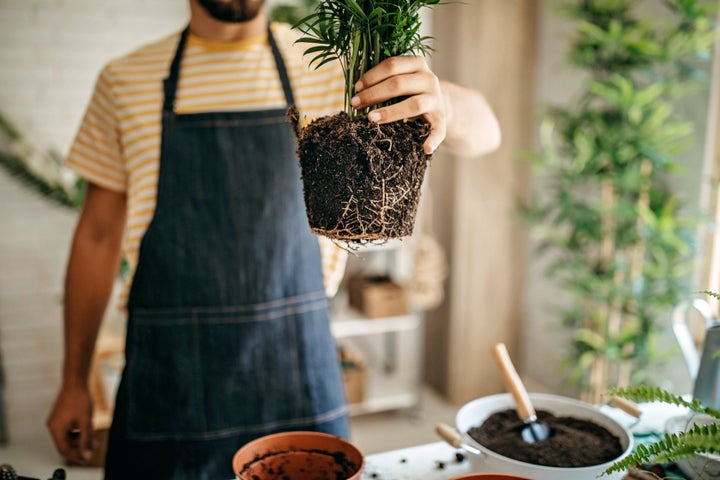
When to repot plants after buying them
You probably don’t want to repot a plant right after you get it. If you just got a new plant that’s still in the container it came in, the experts agree you should give it a few days or even weeks to acclimate to your home before transferring it to a different planter.
You may be interested in putting your plant into a stylish new planter that matches your decor. But one of the biggest reasons you would want to repot a plant is to give it fresh soil, according to Erin Marino, the director of brand marketing at The Sill.
“Repotting your plant does not necessarily mean changing a plant’s current planter, but rather, changing its soil or potting mix because fresh soil means new nutrients,” Marino told HuffPost Finds.
Another reason you might want to repot a plant? If it has grown too big for its current pot — i.e., it’s root-bound. If the plant’s roots have taken up all of the space and begun growing through the bottom of the pot, it’s time for a new home, according to Richard Pham, manager of Little Shop of Soil in Bushwick, Brooklyn.
“Repotting is a stressful time for a plant, so try not to do it too often. Let the plant speak to you. It will tell you when it’s ready for a new home.”
- Richard Pham
Pham said there are a few symptoms of root-bound and pot-bound plants to look out for: the roots are peeking out from the drainage holes, the plant can easily be lifted or fall out of the pot, you see more roots than soil, the plant dries out faster than usual, or it’s been over a year since the plant was last repotted.
“Repotting is a stressful time for a plant, so try not to do it too often,” Pham said. “Let the plant speak to you. It will tell you when it’s ready for a new home.”
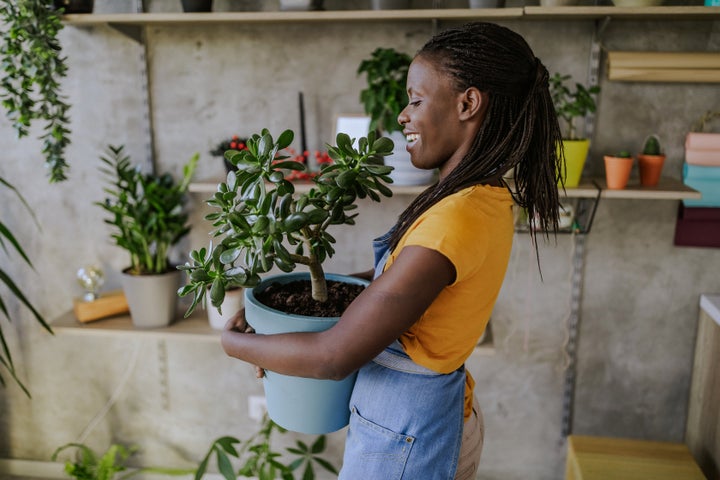
Buying the perfect planter
If your plant isn’t root-bound but does need a refresh, stick to a pot that’s similar in size to the container the plant was in previously. For plants that have outgrown their current pots, size up about 1 to 2 inches to ensure there’s room for growth, Marino said.
Figuring out how to repot a large plant isn’t much different. For larger, floor-sized plants, you’ll likely want to size up 3 to 4 inches, depending on how much you want it to grow.
Planter size is important because you tend to water a plant more when you move it to a larger pot with more soil, Marino said. If you have a small plant in an oversized planter, all that water will be wetting the dirt and not reaching the roots, which can lead to overwatering and possibly root rot. Instead, it’s better to size up gradually over the years.
Make sure the pot you are switching to has a hole in the bottom for excess water to drain onto a saucer, said Joyce Mast, resident Plant Mom (and the founder’s real mom) at Bloomscape. A plant in a pot without drainage is much more susceptible to root rot, damage and even death from overwatering.
If it doesn’t have a drainage hole, Marino recommends layering the bottom of the planter with lava rocks or gravel to create a space for water to pool away from the plant’s roots.
Finally, what materials are best for plant pots? Pham said most plants will benefit from any material that is porous and wicks away moisture, like terra cotta. Certain plants, like ferns and calatheas, that enjoy more moisture might prefer a plastic or ceramic pot.
“Plastic and ceramic pots don’t dry out as fast so I’m able to keep up with watering all my plants,” Pham said. “Once you reach a certain number of plants, you’ll discover little tricks that help you along the way.”
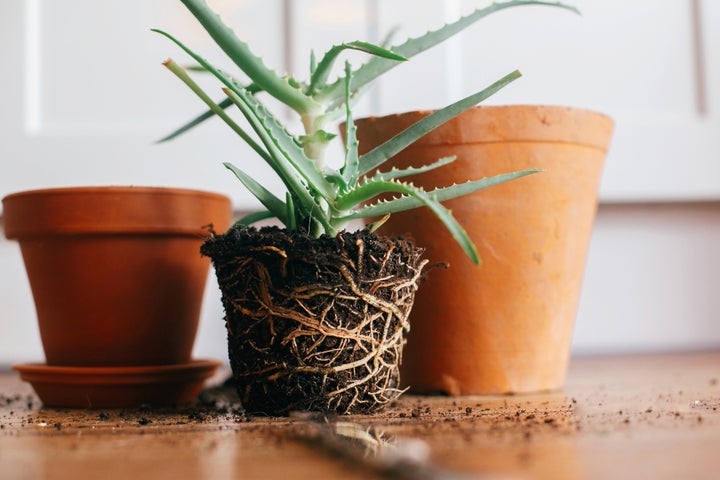
How to repot a plant without killing it
To remove a plant from its current pot, turn the plant sideways, hold it gently by the stems or leaves, and tap the bottom of its container until the plant slides out. You might need to give the base of the stems a couple of light tugs to get the plant out.
“Loosen the plant’s roots with your hands,” Marino said. “If your plant is root-bound — the roots are growing in very tight circles around the base of the plant — unbind the roots as best you can and give them a trim.”
Cutting back any dead, mushy, discolored or excessively long roots with sharp scissors or pruning shears rids the plant of useless roots, Mast said. She also recommends wiping the blades with rubbing alcohol between each snip to avoid spreading bacteria between the roots.
Mast also recommends avoiding repotting in extreme weather like a heat wave, since doing so can add stress to the plant.
“Water your plants a day or two ahead of time so the roots are well-hydrated to avoid root shock,” she said. “Never repot if a plant is wilted due to underwatering. First hydrate, then repot.”
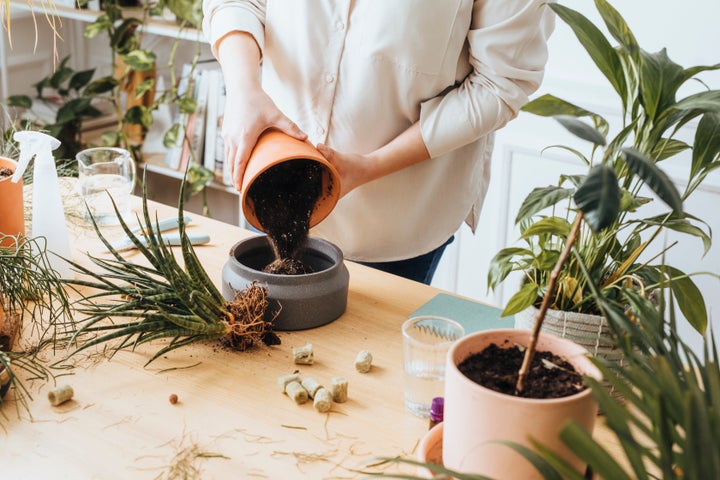
How to add new soil to a potted plant
When your plant is ready for a refresh, remove about one-third or more of its potting mix. Plants absorb a lot of nutrients as they grow, so they need fresh soil from time to time. Pour a layer of fresh potting soil into the new planter and pack it down, removing any air pockets. Just don’t pack it too tight — you want the roots to breathe.
The experts agree you can usually use any indoor potting mix, but Marino usually avoids anything that has an extra benefit like “moisture control” that might throw off her usual plant-care routine.
If your plant is healthy, you don’t need to remove all the old soil, Pham said. Simply loosen the soil on the bottom of the plant so the roots can freely grow. Fill in any gaps, especially on the bottom and sides of the pot, with the fresh soil.
“I always like mixing in some of the old soil into the new soil when repotting,” Pham said. “My reasoning is that the old soil has microbes that the plant has gotten used to and helps give the plant a familiarity to its new home and soil.”
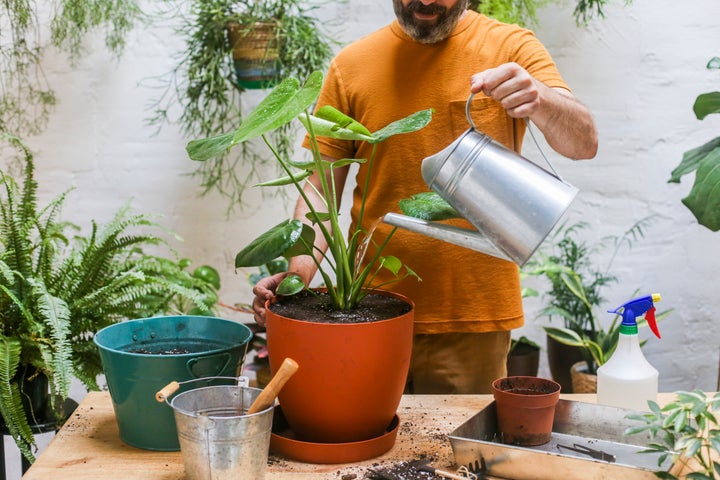
How often should you water indoor plants?
How often you water your plant can vary week to week and even month to month — it all depends on your plant and your home, according to Pham.
After repotting, however, your plant will require a thorough watering to settle into its new pot. Water it until the water flows freely from the bottom of the plant. Allow the plant to “rest” so all the water drains from the pot before placing it on its new saucer. (You don’t want puddling water.)
“I recommend the touch test,” Mast said. “Push your finger into the soil until it reaches your middle knuckle. If the soil feels moist to the touch, do not water your plants and check again in a few days.”
Typically, the problem isn’t how much water you use to water a plant — it’s watering something too frequently. Focus on making sure the water is evenly distributed throughout the pot and soil. Use a watering can if you have it. It’ll help the water come out as a soft steady stream and helps with distribution.
“When water comes out of the drainage hole, that’s your cue to stop watering,” Pham said.
“When water comes out of the drainage hole, that’s your cue to stop watering.”
- Richard Pham
Use a moisture meter to track watering large house plants. If you really want to obsess, keep track of your watering and how your plants react so you can pick up on any patterns. (Pham, who has over 130 plants, uses a spreadsheet.)
It doesn’t really matter what time you water your plants, Marin said, but if you want to get into a routine, she recommends the mornings: “That way your plants can bulk up on water before the sun is shining in full force.”
In general, most tropical plants require water every one to two weeks, while succulents only need water every three to four weeks. Both might require more frequent waterings in the summer with more daily light, and less frequent waterings in the winter with less daily light.
Still want more guidance on keeping your houseplants alive? Below, we’ve rounded up all of experts’ recommendations into one easy-to-browse slideshow, so you have everything you need to get repotting.
Everything you need to repot plants, below: